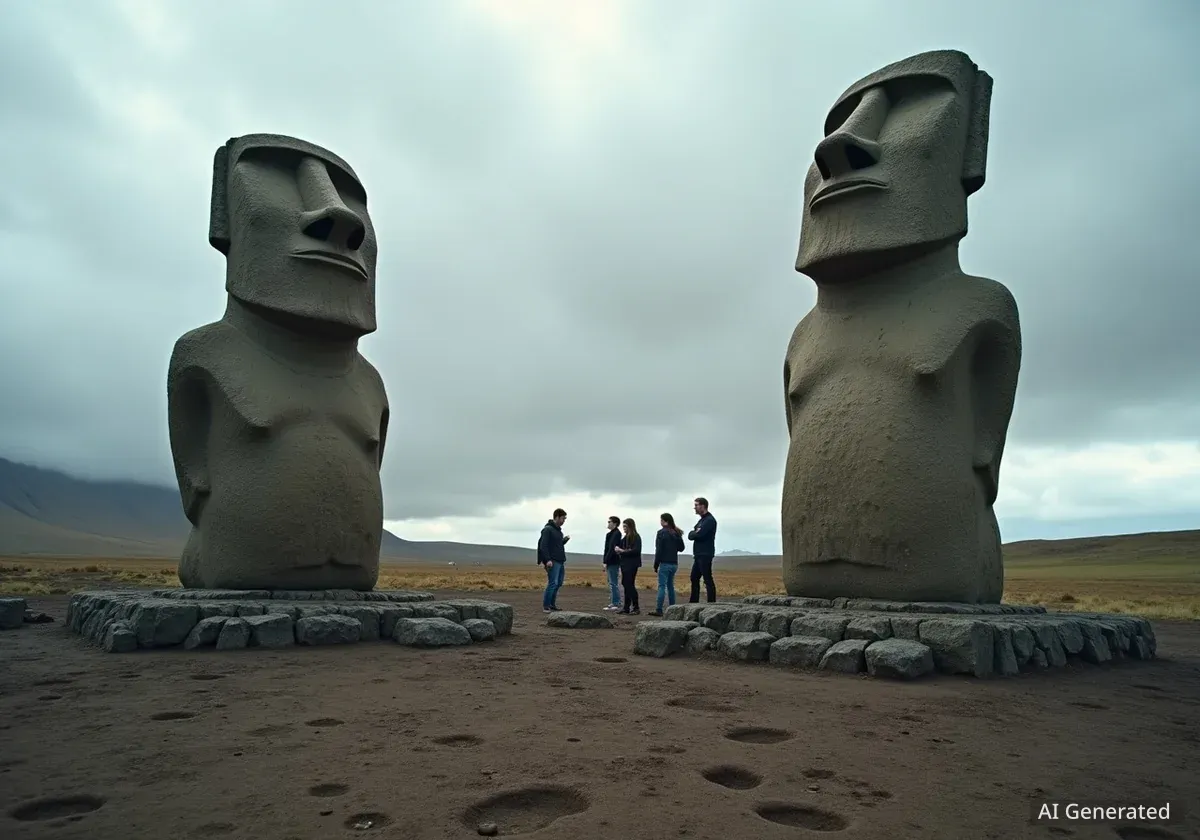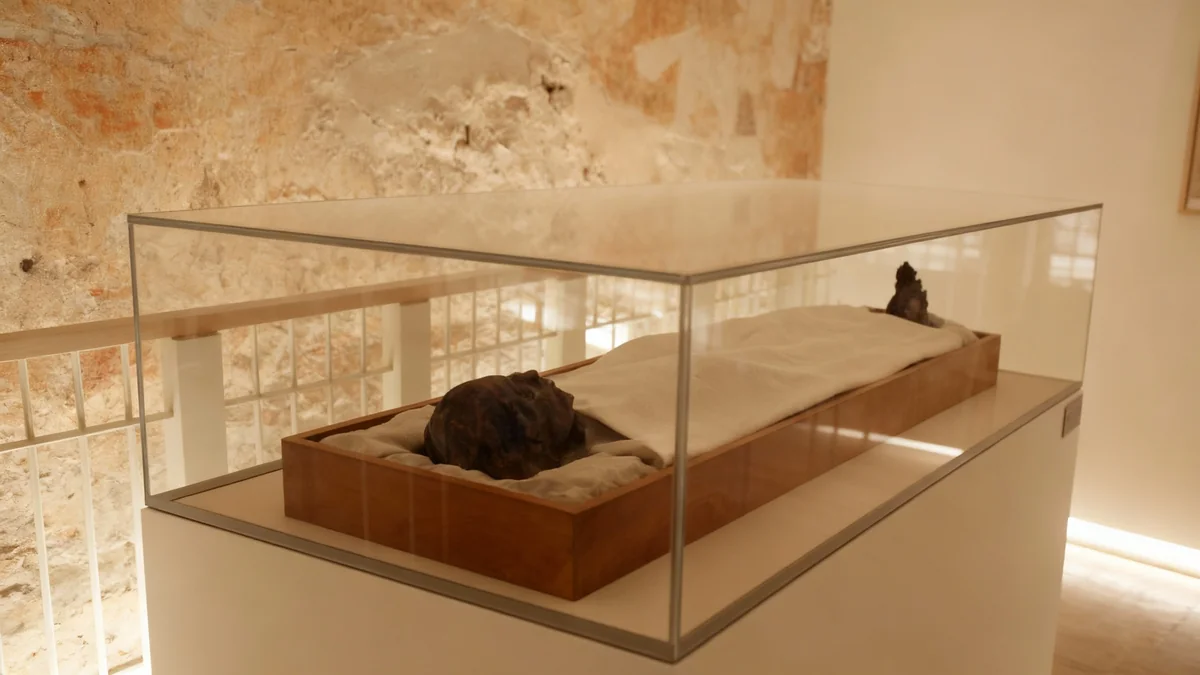Researchers believe they have solved the long-standing mystery of how the giant statues of Easter Island, known as moai, were transported. A new study, published in the *Journal of Archaeological Science*, presents fresh evidence and 3D modeling that supports the theory of the statues 'walking' to their final locations. This method involved workers using ropes to rock the moai in a zigzag motion along specially designed roads.
Key Takeaways
- Easter Island's moai statues were likely moved by 'walking' them upright using ropes.
- New research by Carl Lipo and Terry Hunt offers experimental and physics-based evidence.
- Road moai had wider bases and a forward lean, making them ideal for this transport method.
- Roadways had concave cross-sections, which helped guide the rocking motion.
- The technique required fewer people than previously thought, possibly 20-50 individuals.
The Mystery of the Moai
Easter Island, or Rapa Nui, is famous for its large stone figures, the moai. These statues were carved approximately 800 years ago. They often stand on stone platforms called ahu. For many decades, experts have wondered about the cultural importance of these statues. They also questioned how a Stone Age society managed to carve and move figures weighing up to 92 tons.
One leading idea suggests the statues were moved upright. This hypothesis, supported by archaeologist Carl Lipo from Binghamton University, posits that workers used ropes to make the moai 'walk'. Oral traditions from the Rapa Nui people also mention the moai walking from the quarry to their platforms. One song even tells of an ancestor who made the statues move.
Fact: Moai Weight and Size
- Some moai statues weigh up to 92 tons.
- The largest statues can be 30 feet tall.
New Evidence Supports 'Walking' Theory
While basic field tests in the past showed this method might be possible, the 'walking' hypothesis also faced criticism. To address this, Carl Lipo and his co-author, Terry Hunt of the University of Arizona, published a new paper. This research provides new experimental evidence for 'walking' moai. It uses 3D physics modeling and new field tests to recreate the motion.
When Europeans first arrived in the 17th century, they found only a few thousand people on the small island. Easter Island is only 14 by 7 miles across and thousands of miles from any other land. To explain the many moai, many assumed the island once had tens of thousands of inhabitants. However, Lipo believed fewer workers could achieve the feat.
"I always felt that the [original] experiment was disconnected to some degree of theory—that we didn't have particular expectations about numbers of people, rate of transport, road slope that could be walked, and so on," Lipo told Ars Technica.
Earlier Experiments and Insights
In 2012, Lipo and Hunt demonstrated that 18 people could move a 10-foot, 5-ton moai several hundred yards. They used three strong ropes and a rocking motion. This early experiment provided a proof of concept. In 2018, Lipo also proposed how islanders placed red hats, weighing up to 13 tons, on some moai. He suggested they used ropes to roll the hats up a ramp.
A 2019 paper in *PLOS One* by Lipo and his team concluded that moai locations were likely chosen based on nearby fresh water sources. This was determined through quantitative spatial modeling. The 2012 experiment was a quick test for a documentary. Lipo noted that it lacked detailed predictions and time to explore variables.
Background on Easter Island
Easter Island, known as Rapa Nui, is a remote Polynesian island in the southeastern Pacific Ocean. It is famous for its 887 existing monumental statues, or moai. These statues are carved human figures with oversized heads, typically representing deified ancestors. The island's original inhabitants, the Rapa Nui people, created these impressive works between 1250 and 1500 CE.
Understanding the Physics of Moai Transport
The new research aimed to explore the physics behind the 'walking' method. Lipo explained, "We wanted to explore a bit of the physics: to show that what we did was pretty easily predicted by the physical properties of the moai—its shape, size, height, number of people on ropes, etc.—and that our success in terms of team size and rate of walking was consistent with predictions."
This approach helps counter arguments that the method would not work for larger statues. Critics often questioned if the technique could move a 30-foot, 30-ton moai. Lipo's team believes physics can predict the requirements for such large statues.
Statue Design for Movement
Lipo and Hunt created a database of 962 moai across Easter Island. They used field surveys and photogrammetric documentation. They specifically examined 62 statues found along ancient transport roads. These statues appeared to have been abandoned where they fell during transport.
Their analysis showed that these 'road moai' had significantly wider bases compared to their shoulder width. This wider base created a stable foundation. It also lowered the statue's center of mass. This design made them more suitable for side-to-side 'walking' without falling over. Statues found on platforms, however, had wider shoulders than their bases, making them more top-heavy for display.
Key Design Features of Road Moai
- Wider bases relative to shoulder width for stability.
- A consistent forward lean of 6 to 15 degrees.
- Rounded front base edge to act as a pivot point.
The road moai also showed a consistent forward lean, between 6 and 15 degrees from vertical. This lean moved the center of mass close to or just beyond the front edge of the base. Lipo and Hunt believe this was intentional engineering. While not ideal for stable upright display, this lean was crucial for transport. It caused the statue to fall forward with each lateral tilt, using the rounded front base as a pivot. This action created a forward 'step' with every rocking motion.
Archaeological evidence suggests carvers modified statues after they reached their platform destinations. They removed material from the front of the base to eliminate the lean. This shifted the center of mass over the base area for a stable upright position. Road moai also lacked carved eye sockets, which were added post-transport for white coral eyes with obsidian or red scoria pupils.
Replicating the 'Walking' Process
Using 3D modeling, Lipo's team built a scaled replica of a road moai. This replica weighed 4.35 metric tons and matched the original statue's proportions and mass distribution. "Of course, we’d love to build a 30-foot-tall version, but the physical impossibility of doing so makes it a challenging task, nor is it entirely necessary," Lipo stated. He added, "Through physics, we can now predict how many people it would take and how it would be done. That is key."
The new field trials involved 18 people. Four individuals pulled on each lateral rope, and 10 managed a rear rope. This team achieved the side-to-side 'walking' motion. They moved the replica 100 meters in just 40 minutes. This efficiency comes from basic pendulum dynamics, which minimizes friction between the base and the ground.
Efficiency of the 'Walking' Method
- 18 people moved a 4.35-ton replica 100 meters in 40 minutes.
- The method uses pendulum dynamics to reduce friction.
- It exploits resonance principles for sustained motion.
The technique also uses the gradual build-up of amplitude, suggesting a sophisticated understanding of resonance principles. This means actual statues could have been moved several kilometers over weeks. This would require only modest crews of 20 to 50 people, roughly the size of an extended family or small lineage group on Easter Island. Once a statue starts rocking, only minimal energy input from a smaller team is needed to maintain the motion, primarily for guidance.
Comparing to Earlier Research
Lipo was not the first to test the 'walking' hypothesis. Czech experimental archaeologist Pavel Pavel conducted similar experiments on Easter Island in the 1980s. Pavel's team, inspired by Thor Heyerdahl, demonstrated a 'shuffling' motion. He concluded that 16 men and one leader could transport the statues.
However, Lipo and Hunt argue that Pavel's demonstration did not gain widespread acceptance. It required significant effort to tilt the statue, creating a twisting motion rather than efficient forward movement. This method would have moved a large statue only 100 meters per day in ideal conditions and risked damaging the base from friction.
"Pavel deserves recognition for taking oral traditions seriously and challenging the dominant assumption of horizontal transport, a move that invited ridicule from established scholars," Lipo and Hunt wrote. "His experiments suggested that vertical transport was feasible and consistent with cultural memory."
Lipo and Hunt believe Pavel and others used the wrong type of moai for their tests. They likely used statues already erected on platforms. These statues were modified for vertical stability and permanent display, not for vertical transport. The 'road moai' had shapes better suited for movement.
"Our contribution builds on this by showing that ancestral engineers intentionally designed statues for walking. Those statues were later modified to stand erect on ceremonial platforms, a transformation that effectively erased the morphological features essential for movement," Lipo and Hunt explained.
Evidence from Ancient Roadways
Lipo and Hunt also studied the ancient roadways on Easter Island. These roadbeds had concave cross-sections. This shape would have made moving statues horizontally on rollers difficult. However, the concave shape would help constrain the rocking movement during vertical transport.
The moai roads were also remarkably level, with average slopes of 2–3 percent. For steeper sections, such as ramps leading to ahu, field experiments showed that controlled 'stepping' could navigate them successfully. The distribution of roadways also aligns with the idea of road moai being abandoned due to mechanical failure during transport.
Debate on Moai Placement
Some scholars argue that the positions of fallen moai along roads were ceremonial. Lipo counters that such claims often lack falsifiable evidence. He suggests that while a fallen statue's location might later become ritualistic, assuming purposeful ritual placement requires testable explanations. The construction of roads in segments, with different features, supports the idea of pausing during transport rather than ceremonial placement.
"Arguments that the moai were placed ceremonially in preparation for quarrying have become more common," Lipo noted. "The algorithm there is to claim that positions are ritual, without presenting anything that is falsifiable." He emphasized that explanations must be framed in a way that can be tested.
The Future of Experimental Archaeology
Lipo's work has faced criticism from some scholars. His paper with Hunt includes a section addressing common critiques. Lipo believes that archaeology should build cumulative knowledge based on empirical evidence. "Challenges to these ideas, however, do not come from additional studies with new data but rather just new assertions," he said.
Lipo stressed the importance of building falsifiable accounts and contributing to cumulative knowledge. He highlighted how such research can have empirical consequences, even for something as remarkable as moai transport. Experimental archaeology, especially when combined with physics and chemistry, offers a powerful tool.
"Physics and chemistry are our time machines, allowing us to explain why things are the way they are in the present in terms of the events that occurred in the past," Lipo concluded. "The more we can link the theory needed to explain the present, the better we can explain the past."
This interdisciplinary approach helps researchers understand past events. It provides scientific explanations for archaeological observations. The study's findings offer strong support for the 'walking' hypothesis, shedding new light on the ingenuity of the Rapa Nui people.




